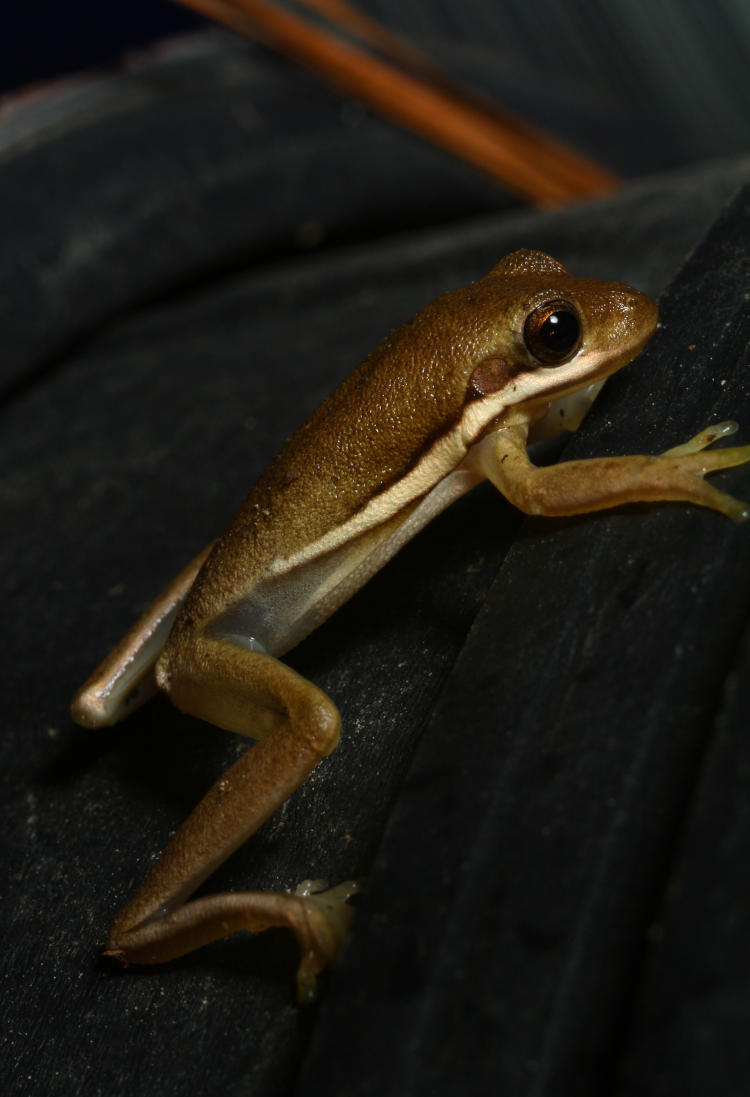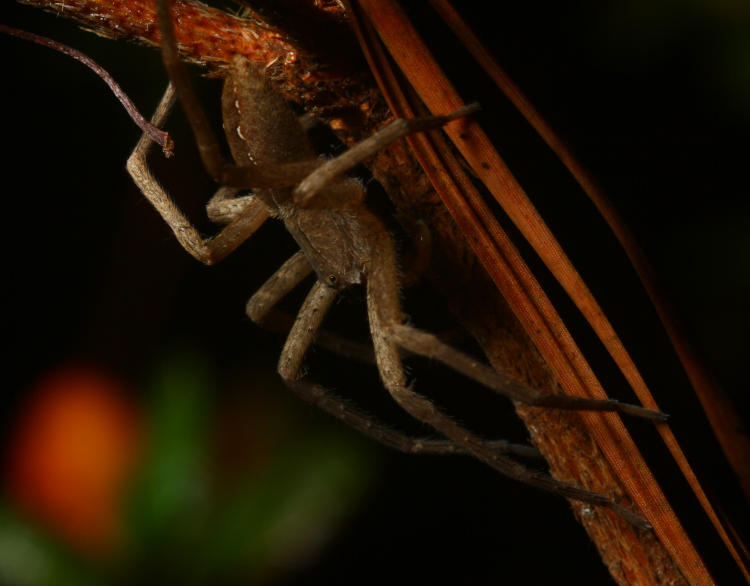I asked a question in the last post title, and answered it in this one. The temperature actually got a tad warmer, held up by a front that brought rain with it, and the green treefrogs (Hyla cinerea) happily took advantage of this brief spring. I’m still a little surprised, thinking they’d be in deep enough cover to prevent freezing and thus not venture out casually, but I’m no herpetologist. I am a nature photographer, so…

There were no less than three in the greenhouse; this wasn’t shocking at all, and in fact, I’d been expecting to see some earlier, since we moved several plants in there before the cold weather set in and I’d suspected somebody had come along for the ride, but I hadn’t seen any until tonight. This is the only adult that I saw this evening, and it was tucked in tight to the trunk of one of the Japanese maples. I’ll include another version just for a minor observation.

If you look closely at the eyes, you’ll see the large round reflection of the flash softbox of course, with an intervening branch in there, but then the two little yellow lights are from my headlamp. They’re actually horizontal, but I was leaning over from above, trying to get a view past numerous small branches, and rotated this image to represent more of the natural perspective.
Two others soon became apparent, being right out in the open.

Now, I can’t say that all three had been in there since we moved the plants within, because last night I apparently didn’t slide the door closed all the way and it was open a crack, enough for their ingress. During the summer I occasionally had to remove one, afraid they’d get cooked in there since they never seemed capable of going out the same way they’d come in, but right now I’m inclined to leave them be.

The greenhouse is a lightweight affair, using plastic panels instead of glass, and so it’s not very well insulated. After some experiments as it got colder at night, we installed a radiant oil heater with its own thermostat, so the temperature never drops below about 12°c, keeping things from freezing while still allowing for dormancy. So the frogs should be all right for the winter, given how they handle a few months without eating or drinking anyway.
And then there were two outside the greenhouse as well.

This one was perhaps the smallest, about 25mm in body length, and a nice bronze color. Over the course of my perambulations around Walkabout Estates, it moved along a decent amount from where I’d initially seen it.

This one was on the fence, and as so often happens, it decided it didn’t like the bright light and turned away as I was trying for a nice portrait angle. Perhaps one day I’ll try a red headlamp and see if they react the same way, but I need a certain amount of light to focus by, so this might not even work.
The treefrogs weren’t the only critters to be found, in about 45 minutes of poking around.

I have no idea what species this ‘inchworm’ larva is, nor am I even going to try. But it’s awful late in the year to be in this instar, and I doubt it’s going to survive the winter. However, I’m not an entomologist either, so take what I say with – okay, with a whole lot more faith than with any anti-vaxxer, because even my wild guesses are far more accurate than their “truths,” while still perhaps a ways from dependable.
I spotted this tiny fly on the tip of the happily-budding burning bush.

It seems rather obvious that it had been sitting there through at least some of the rains, which had stopped hours before I ventured out, but it wasn’t inclined to wait for me to install the extension tube for greater magnification. Because of that, I’m not going to try to identify the species, and just call it a doodyhead.
And one final one, because this post doesn’t have enough photos. Hey, I went a long period without shooting anything, so I’m allowed a little catchup for the end of the year, especially when presented with so many unexpected subjects.

I initially believed this to be a slender crab spider, and I’m not absolutely sure it isn’t, but the markings seem not to match closely; I didn’t get any other perspectives to make a better identification. Spiders are remarkably adapted to the cold, not usually visible when it’s frigid but venturing out immediately as soon as the day gets even slightly warm, ready for any early insects that might appear. So this one wasn’t the least surprising, and a decent size too, running at least 15mm in body length. There were no frogs nor flies visible in the immediate vicinity, so no apparent dangers nor dining, but I also didn’t do a thorough examination; it may have done quite well for itself, or alternately became a frog’s meal.
As I look at the image, the orangish spot in the background has me curious, because I didn’t see any flower buds on the azalea, but it sure looks like that, doesn’t it?
And as I finish this, I hear the rain starting up again, which means it’s pretty heavy since the windows in the office mask the sounds of the lighter, quieter rains very well. Hope they’re all happy with this.



















































